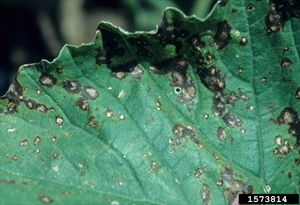Cercospora leaf spot
Pacific Pests, Pathogens and Weeds - Online edition
Pacific Pests, Pathogens & Weeds
Cucurbit leaf spot (145)
Cercospora citrullina: note, previously this has been a name for Dydymella bryonae (now Stagonosporopsis cucurbitacearum) (see Fact sheet nos. 07 & 201)
Asia, Africa, North, South and Central America, Europe, Oceania. It is recorded on cucurbits from Australia, American Samoa, Fiji, French Polynesia, New Caledonia, New Zealand, Niue, Samoa, Tonga, and Vanuatu.
Plants in the Cucurbitaceae or cucumber family - cucumber, melon, pumpkin, squash and zucchini, but mostly watermelon.
On watermelon, the leaves become covered in small, round spots with grey centres surrounded by brown margins (Photos 1&2). The spots may have yellow halos. On cucumber, squash and melon, the spots are angular about 5 mm across, and sometimes the centres of the spots fall out. Later, the spots merge and, on older leaves, large black areas occur, and the leaves die and fall off. When conditions are favourable to the disease, i.e., when temperatures and rainfall are high, infections also occur on the leaf stalk and vines.
The fungus survives between crops in plant debris and also on weeds. The disease is spread when the spores, produced on the underside of the leaves, are blown by wind and also moved in rain splash and irrigation water
The leaf spots are most damaging on watermelon, but the fungus also affects squash. In general, however, leaf spot is a minor disease. In Samoa, it is said to be particularly damaging on leaves of watermelon when they are grown under shade, such as within coconut plantations. The disease can reduce the size of the fruit and also affect quality, but generally losses are not severe. It is also more serious on plants were soil fertility is low.
Look for the small, brown, round spots with grey centres that may fall out. Look to see if the spots merge, especially on watermelon, and large blacken areas develop before the leaves fall off. Young leaves of watermelon are especially susceptible.
CULTURAL CONTROL
Cultural control is particularly important for this disease:
- Remove weeds from within and around the crop.
- Do not plant cucurbit crops one after another on the same land; use a 3-4-year rotation.
- Grow watermelons in full sunlight, not under shade of coconuts or other trees.
- Collect crop debris after harvest and burn it.
RESISTANT VARIETIES
No leaf spot resistant varieties have been identified.
CHEMICAL CONTROL
If chemical control is required, use any of the following products: copper, mancozeb or chlorothalonil.
____________________
When using a pesticide, always wear protective clothing and follow the instructions on the product label, such as dosage, timing of application, and pre-harvest interval. Recommendations will vary with the crop and system of cultivation. Expert advice on the most appropriate pesticides to use should always be sought from local agricultural authorities.
AUTHOR Grahame Jackson
Information from Gerlach WWP (1988) Plant diseases of Western Samoa. Samoan German Crop Protection Project, Deutsche Gesellschaft für Technische Zusammenarbeit (GTZ) Gmbh, Germany; and Schwartz, Gent DF (2007) Cercospora leaf spot (cucumber, melon, pumpkin, squash, and zucchini). High Plains IPM Guide, a cooperative effort of the University of Wyoming, University of Nebraska, Colorado State University and Montana State University. (http://wiki.bugwood.org/uploads/CercosporaLeafSpot-Cucurbits.pdf); and Cucurbit diseases (undated) Cercospora leaf spot. UF/IFAS. University of Florida. (https://plantpath.ifas.ufl.edu/u-scout/cucurbit/cercospora-leaf-spot.html). Photos 1&2 Gerald Holmes, Valent USA Corporation, Bugwood.org.
Produced with support from the Australian Centre for International Agricultural Research under project PC/2010/090: Strengthening integrated crop management research in the Pacific Islands in support of sustainable intensification of high-value crop production, implemented by the University of Queensland and the Secretariat of the Pacific Community.





